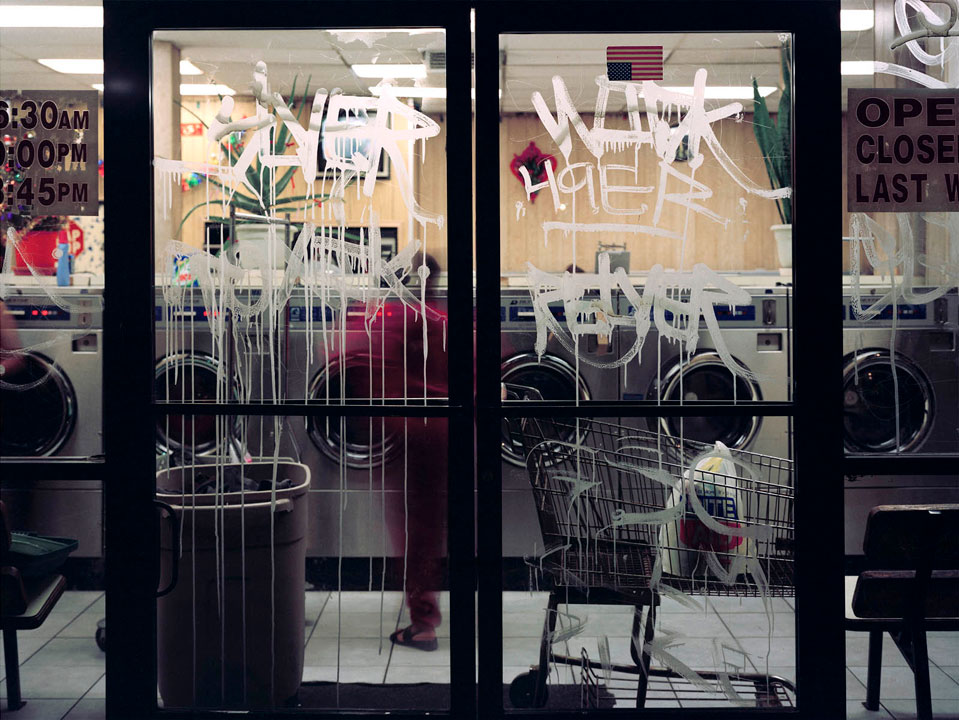Acquisition: Christina Fernandez's "Lavanderia" Series and "Bend" Installation Piece

Christina Fernandez
Lavanderia #1, 2002
inkjet print
image/sheet: 76.2 x 101.6 cm (30 x 40 in.)
framed: 83.82 x 109.22 x 5.08 cm (33 x 43 x 2 in.)
National Gallery of Art, Washington
Gift of David Knaus
2022.46.1
Christina Fernandez (b. 1965), a Los Angeles–based Latinx artist, uses photographs and installations to explore her Mexican heritage and themes of identity, migration, labor, and gender. The National Gallery of Art has acquired six prints from her Lavanderia (2002–2003) series, which depicts laundromats in the Boyle Heights neighborhood of Los Angeles, an area of the city that was known at the time as a bastion of Chicano culture, as well as her installation piece, Bend (1999–2000, 2020). These works not only join others by such Latinx photographers as Benedict Fernandez, Anthony Hernandez, and Ana Mendieta, but also build on the conceptual work of Los Angeles–based photographers Lewis Baltz, John Divola, and Judy Fiskin, who explored the new urban and suburban architecture that was transforming the region in the 1970s and 1980s. All are now represented in the National Gallery’s collection.
Lavanderia #1, 2, 4, 8, 9, and 11 depict the familiar scene of a laundromat at night. By focusing tightly on its windows and eliminating peripheral elements, Fernandez forces us to look carefully at this space. Working at night and using a 4 x 5 inch camera and long exposure times, Fernandez created highly detailed pictures that record domestic labor as it is transacted in public. Lavanderia #1 is the most widely celebrated picture from this series. Its calligraphic and nearly illegible graffiti, with numerous drips and splats, amplify and obscure the movement of the people within the laundromat, highlighting the sterility of the environment. Fernandez shows them performing a very personal act—washing their clothes—in a very public space, many after working all day. While she has often explored, in her words, "the blur of labor, the anonymity of the laborer, the stillness of leisure," Lavanderia #1 also addresses, as Edward Hopper did, the light that emerges from buildings at night, infusing psychological tensions into everyday life.
In 1999 and 2000 Fernandez traveled to Oaxaca, Mexico, to explore her family’s connection to the region and to the ancient Zapotec ruins at Monte Albán. Although she photographed there, the project remained unresolved until 2020 when she conceived Bend (1999–2000, 2020). Fernandez created a wall mural with a print of Monte Albán and five photographs hung over it—four smaller photographs of the ruin and its surrounding landscape, and one of her body smeared with dirt. She also printed a text on the mural about her experiences in Oaxaca as she sought to bridge the gap between herself and the landscape, and between herself and her family back in California. The title Bend refers not only to her need to reflect light into the darkened chambers of the ruin, but also to the act that she and her family, as well as all immigrants, perform as they leave one culture and bend their lives to adapt to a new one. Together these elements create a powerfully evocative installation about identity, migration, and loss.
Contact Information
General Information
For additional press information please call or send inquiries to:
Department of Communications
National Gallery of Art
2000 South Club Drive
Landover, MD 20785
phone: (202) 842-6353
e-mail: [email protected]
Newsletters
The National Gallery also offers a broad range of newsletters for various interests. Follow this link to view the complete list.